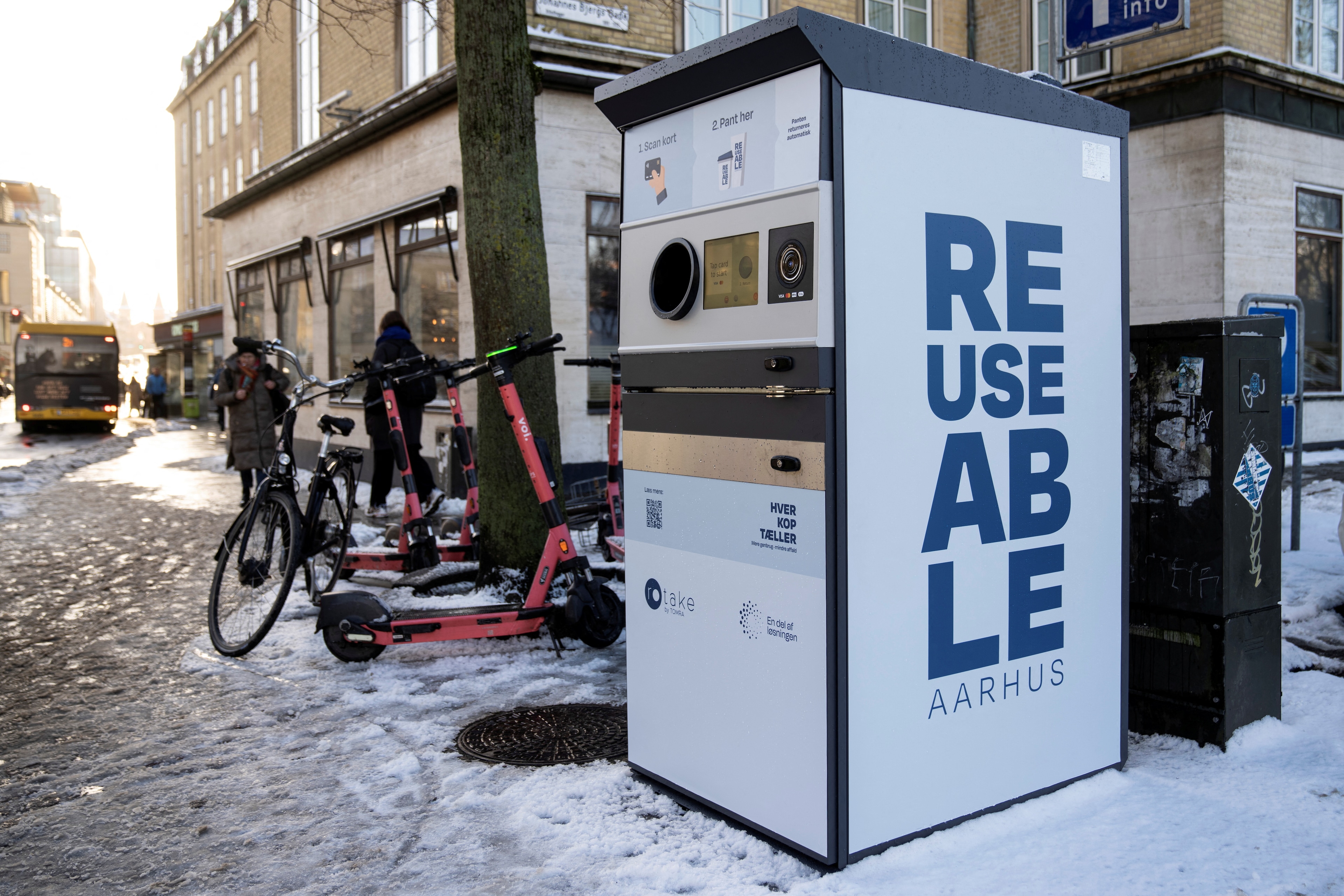Is ‘materials matching’ the new weapon in the climate war?
By recycling parts, General Motors has reduced its carbon footprint by millions of tons
Image: REUTERS/Sergei Karpukhin
Stay up to date:
Future of the Environment
For corporate leaders who view the carbon-reduction goals of the Paris Agreement as an opportunity rather than a mandate, a new materials marketplace offers the chance to shrink environmental footprints while bolstering bottom lines.
If we’re going to reduce average global warming to 2 degrees Celsius, we’re going to need more efficient material flows. Material reuse and recycling offer additional strategies for reducing carbon, in part by reducing the emissions involved in extracting and transporting raw materials. If the United Nations Framework on Climate Change were to adopt material reuse as a carbon-reduction strategy, it would greatly accelerate interest from all sectors in establishing the circular economy/industrial ecology approach.
But moving from rhetoric to reality isn’t easy. It requires a change in thinking for those accustomed to a linear path of taking materials, using them to make products and scrapping whatever is left. Forms of the circular economy have been around for decades, under varying names, including “by-product synergy” and “industrial symbiosis”, typically at the local or regional level. Businesses have more incentive today to squeeze every gram of potential out of the materials they use. The marketplace, which offers the following materials, helps them do that.
Source: usbcsd.org
Participants in the United States Materials Marketplace work hand in hand with materials experts using a sophisticated online database to discover new ways of reusing or exchanging unwanted materials, from textile scraps and hydrochloric acid to off-spec wood flooring. Not only do they save money as they acquire cheaper raw materials and create less waste, but they have significantly reduced the amount of energy they use and they emit lower levels of greenhouse gases.
A resource out of place
While this “materials matching” has been tried many times before, several developments make now a good time to try turning it into a normal business practice. These include growing corporate buy-in, evolving sophistication of intelligent software and the momentum for climate change solutions coming out of the Paris Agreement.
As the materials marketplace expands globally, it will offer access to a growing database of reuse possibilities. Organizations interested in establishing circular supply chains or those with material solutions can use it to connect with colleagues and customers, explore new supply chains and test new markets. Like Airbnb and Uber, development of a materials-trading centre is an example of the transformative possibilities of the shared economy.
One market leader, General Motors, has generated nearly $1 billion in annual revenue by reusing and recycling its by-products, from scrap steel to worn tires. In the process, it avoided releasing more than 10 million metric tons of CO2-equivalent emissions in 2014.
Socially beneficial reuse discoveries can also enhance a company’s reputation. Applying its mantra that “waste is a resource out of place”, GM donated leftover materials from the production of Chevrolet and Buick sedans to an entrepreneur to create insulated coats that transform into sleeping bags for homeless people. Could the reuse of material help architects and designers establish shelters for the world’s surging refugee flows?
Game, set and match
Another marketplace champion known for its creative reuse strategies, Nike grinds down worn athletic shoes to create sports courts and playground surfaces. GM and Nike are among the 23 multinational companies that participated in a pilot project that began over the summer of 2015 to test the feasibility of establishing a US materials marketplace. These companies, with 78 facilities, uploaded 150 materials (the equivalent of 2.4 million tons) to the marketplace in six weeks. Sixty-eight matches were recommended by US BCSD expert staff, 19 of which were being developed when the first phase of the pilot ended.
A second phase of the project launched in January 2016, and we hope to have more than 100 companies involved by the end of 2016. Among those already participating are Alcoa, Armstrong World Industries, BASF, CH2M, Dow Chemical, Essroc, Fairmount Santrol, Goodyear, Greif, LafargeHolcim, Novelis, Procter & Gamble, Starbucks, Swisstrax, Tetra Pak, Veolia, and Waste Management.
Advances in materials matching
The matching process has come a long way from the days when we were literally standing over spreadsheets analysing how we could pair companies with materials they either needed or wanted to unload. Those trades are now taking place on a cloud-based marketplace platform in places like Austin, Texas, where the US BCSD won a six-year city contract in 2014 to set up and run a materials marketplace. Because the database is confidential and secure, corporations and entrepreneurs are more confident when it comes to sharing information with city departments and other participants about their material flows. Government agencies in Ohio and Tennessee are considering establishing similar state-level marketplaces.
In each case, a project team helps participants, from microbreweries to multinational companies, tackle the technical demands of uploading materials and finding matches. Finding ways to include smaller players in a national effort has been a challenge. As a former editor and reporter for the Associated Press, a cooperative network that is owned and used by thousands of US news organizations, I thought a similar cooperative approach could work for materials marketplaces.
When the AP began, newspapers accustomed to guarding their information and competing to get the news out were just discovering the advantages of pooling their resources and sharing information. Just as small-town newspaper readers gained access to a world of news, companies participating in a co-op style materials marketplace could tap into a tremendous data set of reuse opportunities.
To help make that happen, we are working on establishing a tiered cooperative model that would allow for big and small marketplaces to share their outcomes. As other countries implement their own marketplace programmes, this co-op structure would connect them while allowing participants to retain control and ownership of their country’s data and activities.
The path to sustainability
One challenge in identifying reuse opportunities has been that different people within a company have pieces of information they may not have had a reason to share. The marketplace allows companies to add multiple users so that creative material reuse becomes a company-wide effort. In a regional market, companies trying to avoid the expense of transporting unwanted materials over long distances are more likely to find a match nearby. Marketplace experts are also exploring the possibility of making longer-distance shipments more affordable by tapping into empty cargo spaces transporters move daily.
Looking ahead, as we seek to expand the materials marketplace, we’re encouraged by the interest received from numerous organizations, including the European Bank for Reconstruction and Development, the Group of Seven (G7) countries, the US Environmental Protection Agency and Departments of Energy and State.
Reimagining industrial systems in ways that mimic nature’s material flows creates opportunities to expand business approaches that are economically, environmentally and socially beneficial, paving the way to a more sustainable future.
Have you read?
Circular economy: what it means and how to get there
The Paris climate agreement – what happens now?
Are we moving into a post-plastic world?
The US Materials Marketplace pilot project is the culmination of 20 years of materials management efforts in America, China and the UK by the United States Business Council for Sustainable Development (US BCSD), which launched it during the summer of 2015 with collaborators Corporate Eco Forum and World BCSD. In January 2016, the US Materials Marketplace was recognized by the World Economic Forum as the winner of its 2016 global Circular Economy Digital Disruptor Award.
Don't miss any update on this topic
Create a free account and access your personalized content collection with our latest publications and analyses.
License and Republishing
World Economic Forum articles may be republished in accordance with the Creative Commons Attribution-NonCommercial-NoDerivatives 4.0 International Public License, and in accordance with our Terms of Use.
The views expressed in this article are those of the author alone and not the World Economic Forum.
Related topics:
Forum Stories newsletter
Bringing you weekly curated insights and analysis on the global issues that matter.
More on Circular EconomySee all
Tom Crowfoot
August 20, 2025
Kaiser Kuo and Kateryna Gordiychuk
August 15, 2025
Henrik Hvid Jensen
August 7, 2025



